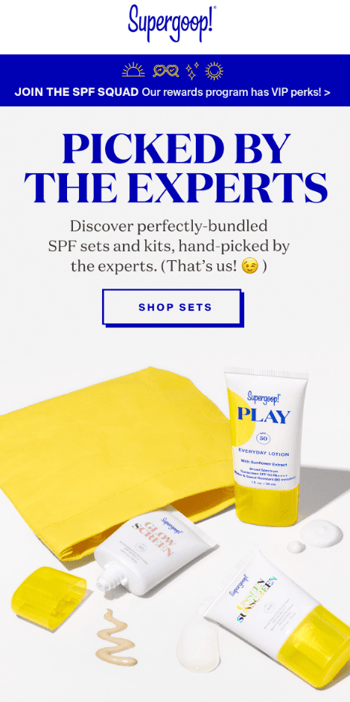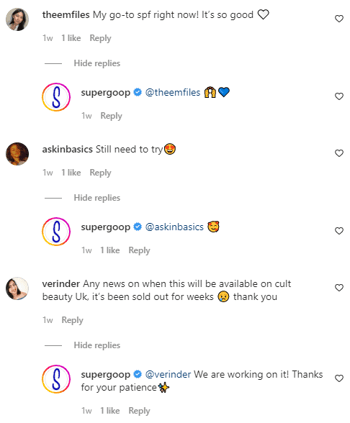Product Page Optimization: 5 Best Practices and Tools to Use
Are your product pages optimized to engage shoppers? This post explains five important product page best practices and ecommerce tools to put them...
Want to ramp up your brand’s average order value? This guide breaks down how to increase AOV and examples of how ecommerce brands actually do it.


Have you fully unlocked your storefront's sales potential?
If you’re not 100% sure, your average order value (AOV) can clue you in.
As ecommerce sales continue to surge, consumers aren’t shy about spending more when shopping online.
Even so, competition is fierce among merchants. Instead of obsessing over new customer acquisition, it’s so much more proactive (and profitable!) to focus on increasing your AOV.
Because when your average order value goes up, you maximize sales with your existing customers and new buyers alike.
You’ve already done the hard part of winning over customers — so now what?
Below we break down everything you need to know about AOV in ecommerce and actionable ways to increase yours.
Skip to a Section 👇8 Proven Strategies to Increase AOV |
Let’s kick things off with a quick average order value definition we can work with.
AOV is a calculation of the dollar average amount spent per customer at your store.
In short, your AOV highlights how much a “typical” customer spends at checkout. This metric is always measured over a specific timeframe (think: 30 or 90 days).
AOV is often cited among the most important ecommerce metrics to track — we agree. Simple to calculate, measuring your AOV is one of the easiest ways to keep a pulse on your store’s performance.
Below is a basic AOV formula that you can follow:
Revenue / # of orders = average order value
Now, let’s put our formula into action. Let’s say your storefront earned $4,000 in the past 30 days through a total of 67 orders.
$4,000 (revenue over [x] time period) / 67 (# of orders) = $59.70 (average order value)
And so your AOV would be $59.70 for that period.
That's it! We weren’t kidding when we said AOV was easy to calculate.
Whether you keep track of sales through an ecommerce platform, Google Analytics or even a spreadsheet, this formula is fair game. Average order value is likely front-and-center on your ecommerce dashboard, too. Here’s an example of AOV in Shopify:
The short answer? It depends!
From your offerings to your industry, consider the variables that influence your AOV.
For example, how wide is your price range? Do you only sell a handful of products? Are most of your orders for the exact same product?
A “good” AOV is totally relative. Comparing the average order value of a budget beauty brand versus a luxury retailer is apples and oranges.
Still, we do have data that highlights how much the average consumer spends online. For context:
While these numbers might not reflect your business or industry, they do illustrate how much the average shopper is willing to spend. This is exactly why merchants should strive to level up their AOV versus settling on sub-par sales.
Despite popular belief, you don’t need to transform your storefront or raise prices to increase AOV.
In fact, there are some surprisingly low-hanging tactics that just about any merchant can roll out.
Below are eight ways to boost your average order value sooner rather than later. For each strategy, we’ve provided examples, research and anecdotes of how these tactics actually work.
Putting together a product bundle is probably the easiest way to drive bigger purchases.
That said, it’s also one of the most effective strategies on our list.
 Source: @herrmanndigital
Source: @herrmanndigital
Bundles and product “starter kits” might not be breaking news but there’s a reason why so many ecommerce brands rely on them.
For starters, bundles create a larger initial purchase amount for first-time buyers. Giving shoppers a larger sampling of what you have to offer also creates more opportunities for repeat business. Think about it: putting three items in someone’s hands is better than one.
Oh, and product bundles are simple to put together. For example, you might build bundles based on:
For example, Pepper promotes a starter kit bundle that features their best-selling bras. Best-sellers are a brilliant choice for bundles because of the built-in proof of your satisfied customers. Otherwise, they wouldn’t be best-sellers.


Source: Pepper
Below is another example of a product bundle from Fellow. Labeled as “everything you need,” this coffee bundle encourages buyers to make purchases now that they’ll otherwise make in the future.


Source: Fellow
Rather than hope that your customers return for more, bundles ensure they get what they need upfront. This ultimately creates a better customer experience and drives up your AOV at the same time. It’s a win-win!
The growing expectation of free shipping among consumers is clear.
And if you aren’t offering it, you’re likely leaving money on the table.
Introducing a minimum free shipping threshold should be a matter of “when” and not “if” for ecommerce brands. You’d be surprised at how many shoppers would be happy to add more to their carts if it meant not having to eat a surprise shipping fee.
For example, Aerie highlights how much more to spend to earn free shipping when you add an item to your shopping cart. This serves as a subtle nudge for shoppers to keep browsing.

Source: Aerie
Free shipping status bars are huge in ecommerce right now, too. These bars almost gamify the shopping experience, urging shoppers to reach a “complete” cart for free shipping. Below is an example from Allbirds.

Source: Allbirds
There is no one-size-fits-all approach to pricing a free shipping threshold. We’ve seen everything from no-strings-attached free shipping to $100+ minimum purchases. Finding the “right” minimum depends on your business, industry and shipping costs.
You shouldn’t be afraid to keep your minimum amount for free shipping on the higher-end, though. After all, you can’t increase AOV if you’re being crushed by shipping costs yourself.
 Source: @jbryanporter
Source: @jbryanporter
Below is an example of how thresholds can boost sales. Glossier automatically suggests products to help customers reach their minimum amount for free shipping. This drives bigger shopping carts without forcing visitors to aimlessly browse or potentially bounce off-site.

Source: Glossier
And hey, this actually leads us directly to our next tactic!
Upselling and cross-selling are probably the most popular tactics for increasing AOV.
The concept is simple enough, right? Doesn’t putting more products in front of people mean more chances to earn sales?
Not necessarily.
Consider that the average consumer is overwhelmed by product choices and likewise has a relatively short attention span. Upsells and cross-sells need to be quick, seamless and require as little work on behalf of your shoppers as possible. Otherwise, you risk losing ‘em.
That’s why upsells are often done shortly before checkout, inviting shoppers to add more to their carts. This leads to less second-guessing and more action.
Krave Beauty does an awesome job of upselling shoppers by suggesting extras to reach their free shipping threshold.
.gif?width=700&name=Krave%20Beauty%20(free%20shipping%20+%20upsell%20fewer%20frames).gif)
Source: Krave Beauty
The upsell itself works because it’s not in-your-face but not too subtle. Getting your upsell right is a sort of balancing act and Krave pulls it off perfectly.
Check out how Outer suggests complementary products to couple with your purchase. Notice how they suggest both a premium and lower-cost item. Whether it’s $1000 or $10, anything you can do to increase AOV is a plus.

Source: Outer
Here’s another example from Zenni, upselling “recommended” extras to go along with your next pair of glasses. This upsell feels natural because the products complement the original item being purchased. Remember: upsells and cross-sells should be relevant, not random.

Source: Zenni Optical
Both upselling and cross-selling are low-risk ways to increase AOV, granted you don’t interrupt your customers. Subtle reminders to buy are obviously ideal versus full-screen takeovers and pop-ups.
Subscription services and “subscribe-and-save” offers have taken over ecommerce.
For consumers, they mean receiving products on a regular basis with no hassle. For merchants, subscriptions represent long-term, reliable revenue. One of the biggest direct-to-consumer trends of 2022, brands are figuring out how to increase AOV through subscription offers.

Source: @itskrystalewis
For example, Facetory offers a 20% off subscribe-and-save option to create longer-term customers.

Source: Facetory
Meanwhile, Sock Fancy offers a sock subscription service beyond their regular shop.

Source: Sock Fancy
This is actually a case where doing more business can actually bring down your AOV (at least in the short term). That’s because the savings from subscriptions might reduce the amount spent per order.
Then again, this isn’t always the case (especially if your subscription service cost exceeds your current AOV). Still, long-term subscriptions are going to drive more revenue than one-off purchases.
Time to tap into some buyer psychology! Product comparison charts are an underrated way to invite shoppers to consider larger purchases.
The fact that comparison charts are scattered all over Amazon speaks for itself. Charts simplify the shopping process and answer must-know questions for shoppers on the fence.

Source: @_davecisek_
Below is a straightforward example of a product comparison chart from Nespresso. What’s notable here is that the product prices aren’t arranged in ascending order. This encourages shoppers to browse the entire table of features instead of just zeroing in on the price tag. In turn, shoppers become aware of what they might miss by choosing a cheaper option.

Source: Nespresso
The key to making comparison tables work is not to undersell your budget or lower-cost items. After all, a small sale is better than no sale at all.
Like bundles, the concept of BNPL isn’t exactly breaking news.
Simply put, buyers can split their payments into smaller monthly installments at checkout through BNPL platforms. You’ve probably come across your fair share of call-outs to Afterpay or Klarna while shopping yourself.

Source: lululemon
According to data from Afterpay, SMBs can increase AOV from 10-20% simply by introducing BNPL. The same report notes that two-thirds of SMBs using Afterpay report a boost in sales, too.
The value of BNPL for merchants isn’t much of a surprise. Through flexible payments, consumers are able to spend more than they otherwise could.

Source: @madebylanzi
Giving customers a sense of freedom and flexibility can translate into a higher AOV. Even if you’re not 100% on board with BNPL yourself, having the option is an expectation of many consumers in 2022.
Data from Barilliance notes that returning customers spend 16.15% more per transaction than new customers.
And so figuring out how to increase AOV starts by keeping your current customers coming back.
Again, earning that initial sale is the hard part. If people already know you and trust you, make sure you make a conscious effort to engage with them after the fact. This means:
For example, Supergoop regularly sends emails to recent and past customers to keep them engaged and in the loop. The promo email below earns bonus points for featuring a bundle!

Source: Milled
Meanwhile, the brand regularly features customers in their social feeds via user-generated content. This highlights how the brand values customer relationships and wants to hear from their fans. This results in greater engagement and more UGC.

Source: @supergoop
The brand likewise makes a point to answer questions to reply to shout-outs via social as well.

Source: @supergoop
We’ve seen firsthand how ongoing social media engagement is one of the best ways to reduce customer churn, win UGC and drive more sales. Don’t forget that a higher AOV goes hand in hand with happy customers.
Customer photos. Glowing reviews. Shout-outs and recommendations.
For the sake of standing out, social proof is crucial for modern ecommerce brands. As an added bonus, user-generated content like customer photos and reviews also has a positive impact on conversions. The connection between user-generated content and higher spending is well-documented.
This explains why we’re seeing social content pop up across more ecommerce websites and product pages. For example, Good Dye Young promotes multiple on-site feeds of customer photos sourced from Instagram.

Source: Good Dye Young
These photos are not only featured on the brand’s homepage but also on individual product pages. This allows shoppers to see what their specific shades of hair dye look like on actual customers without having to leave the site. This can translate into lower bounce rates and more split-second purchases.
Lift Down features real people on their product pages, too.
.gif?width=700&name=Liftdown%20gif%20(real%20photos%20on%20product%20page%20example).gif)
Source: Lift Down
They also feature a review section where customers can share snapshots of their latest fits. Seeing real customers in real-world settings makes shoppers feel more comfortable and confident in their own purchases.
.png?width=700&name=Liftdown%20(product%20page%20reviews%20and%20UGC).png)
Source: Lift Down
These tactics highlight the value of sourcing and repurposing UGC. Doing so helps you earn the trust of shoppers and build a greater sense of loyalty among your customers.
Good question! If your ecommerce dashboard automatically tracks AOV, there’s no reason not to check it daily.
But because AOV is measured over a designated time period (typically 30 days), month-to-month and quarterly reports are ideal for assessing your store’s growth. This gives you enough time to spot trends in your data and customer behavior. Month-to-month tracking is realistic and reasonable for merchants of all sizes.
Also, monthly reports won’t be as impacted by outliers (think: a massive one-off purchase). Consider how variables such as seasonality can impact your AOV, too. If your sales typically spike during the holidays, keep that in mind for any given reporting period.
Chances are that you’re already keeping track of your fair share of data points, right?
We hear you!
Still, tracking your average order value should be a priority metric for any ecommerce business. Consider the benefits:
Increasing AOV clearly goes hand in hand with earning more money as a merchant.
But that’s not the only reason why your order value matters.
By putting AOV under the microscope, you’re driven to explore new opportunities to optimize your ecommerce presence and build better relationships with your customers. Doing both ensures the longevity of your business.
Increasing your average order value isn’t just a one-and-done process.
Making it happen means experimenting with new marketing tactics and ways to engage your audience.
And we've seen influencers’ positive impact on loyalty and brand awareness firsthand.
The more people you have spreading the word and posting about your brand, the better. Starting an influencer campaign from scratch is no small feat. The good news? Statusphere can kickstart and scale your influencer campaigns from zero.
Our full-service platform simplifies and speeds up the process of getting your products in the hands of relevant influencers. We handle everything from delivery and vetting creators to analyzing the success of your campaigns once they’ve live.
Want creators to start posting about your brand ASAP? Chat with one of our consumer-to-consumer marketing experts today to see how we can help.
Are your product pages optimized to engage shoppers? This post explains five important product page best practices and ecommerce tools to put them...
Looking for lessons from the best DTC brands? This guide breaks down 8 top direct-to-consumer companies and how they engage customers.
Branded hashtags are an effective but misunderstood tool for brands on Instagram and TikTok. This post explains how to create your own (and why you...
Be the first to know about the latest tools, trends and strategies in influencer marketing for brands.